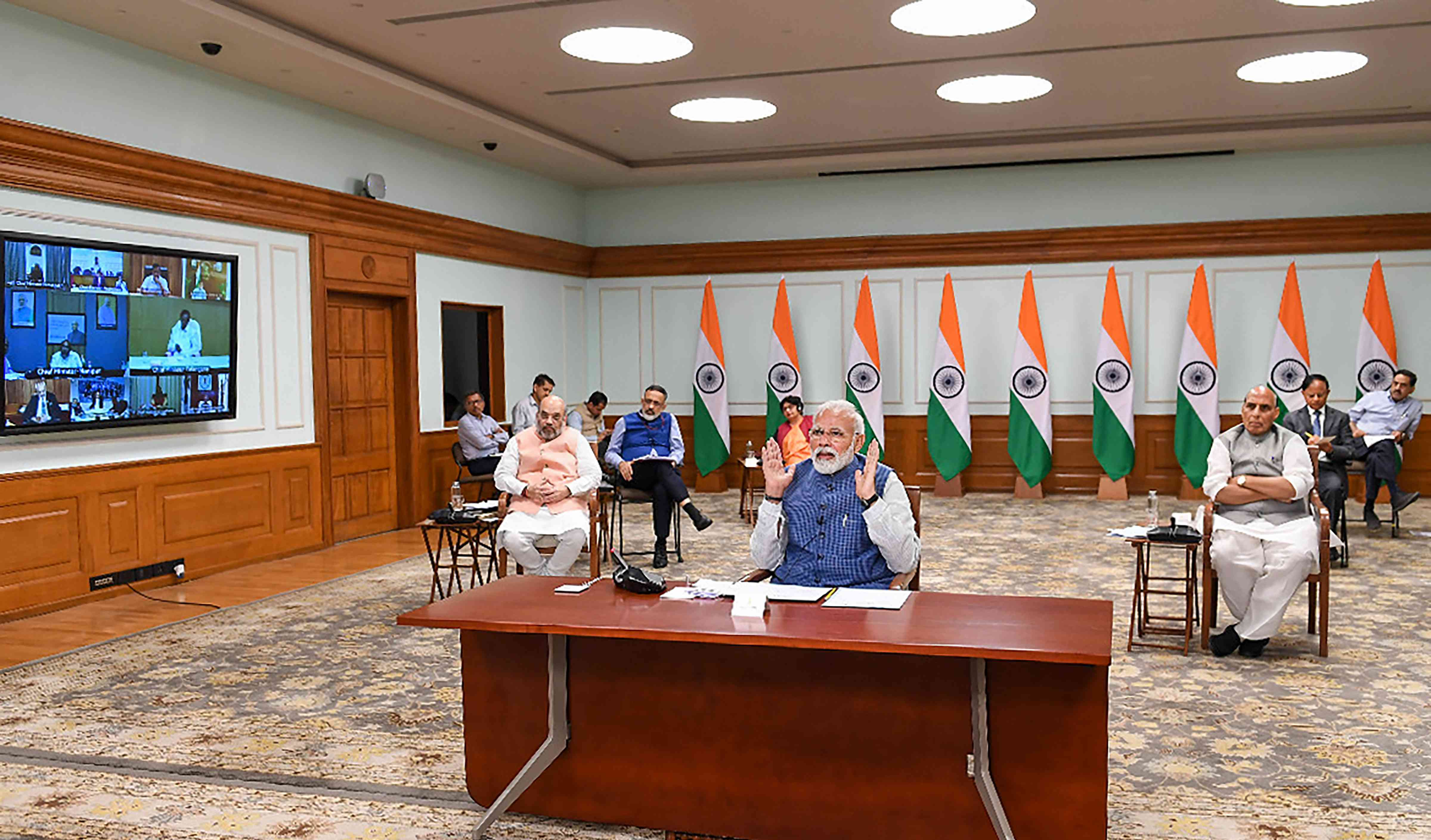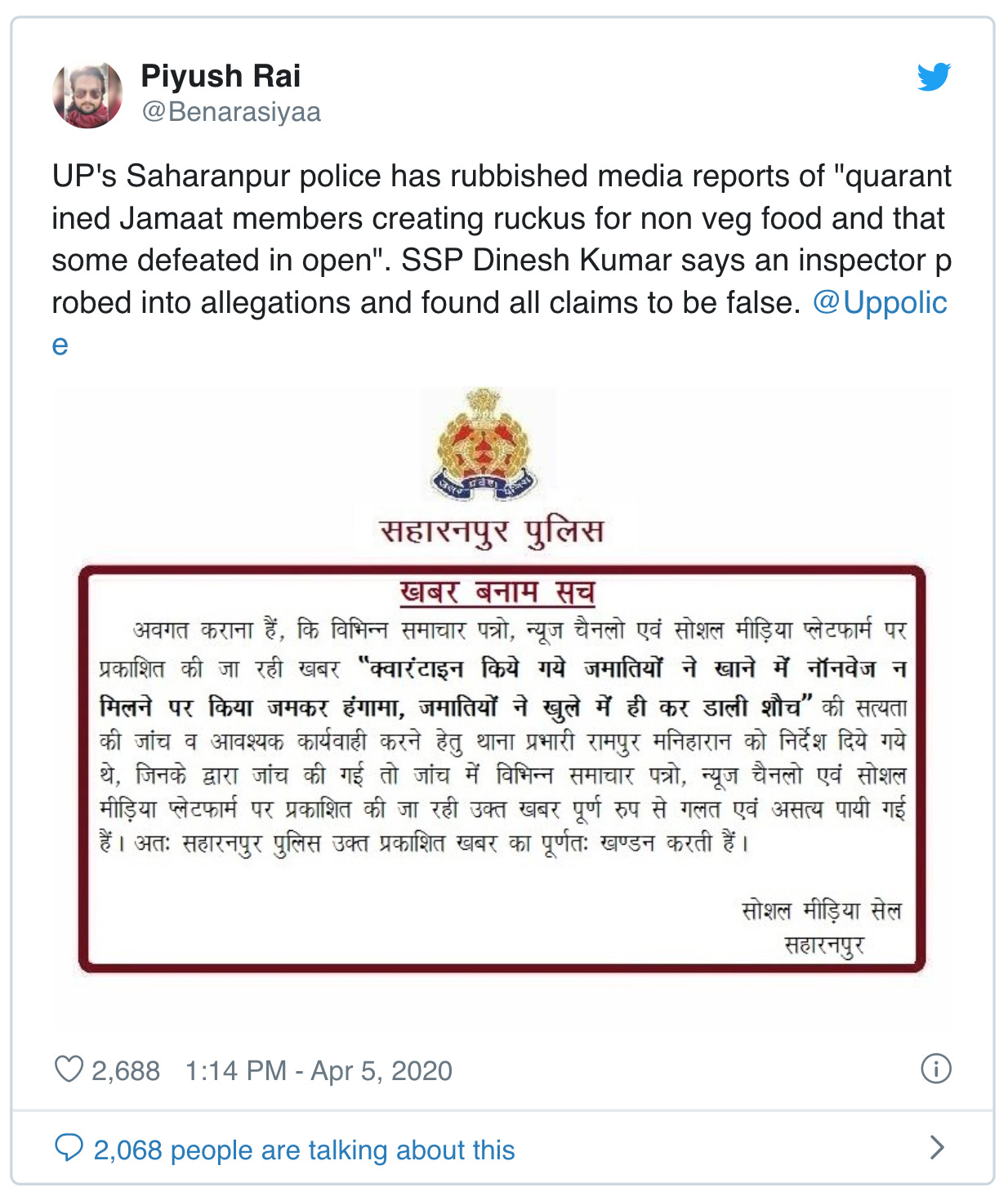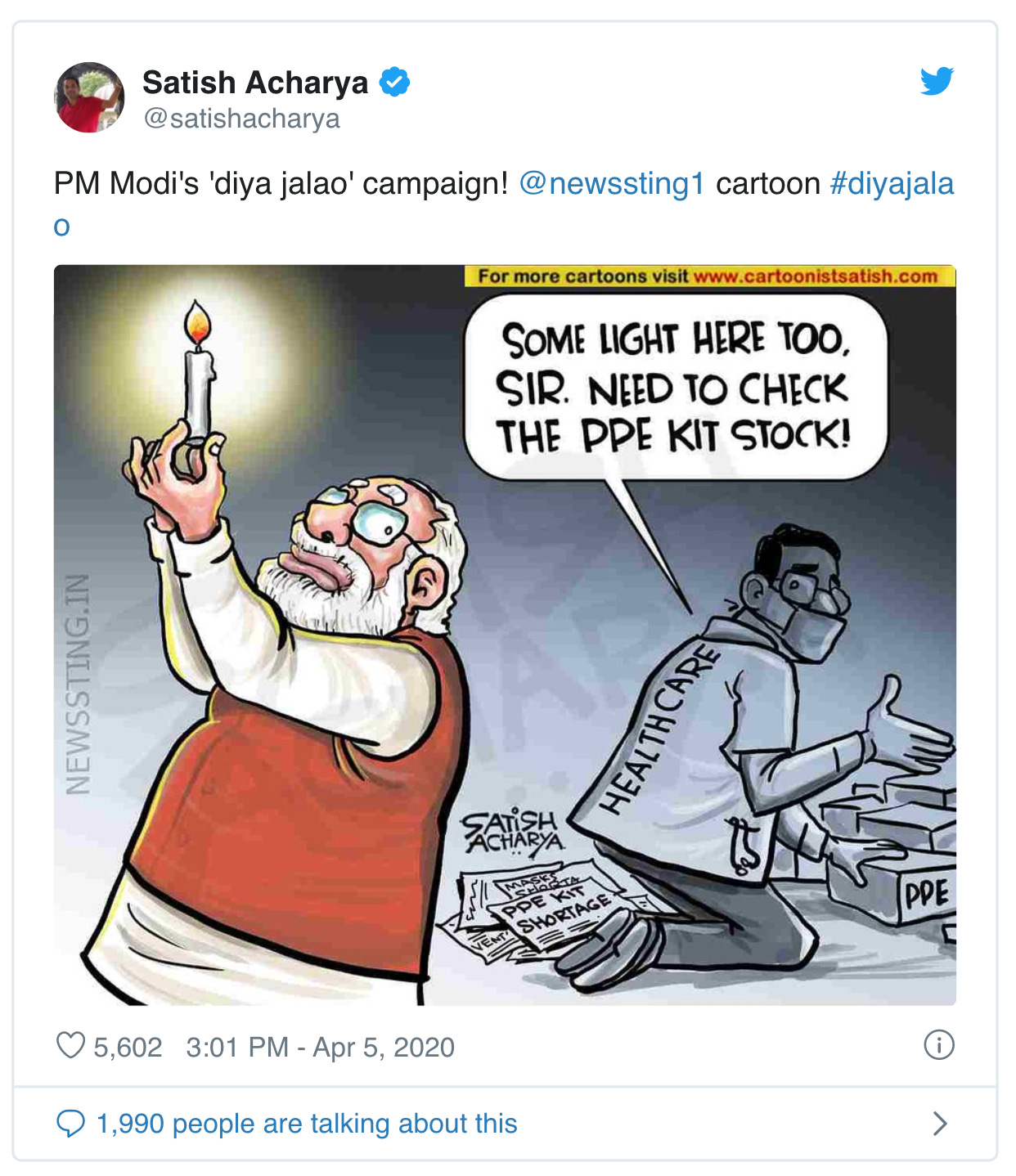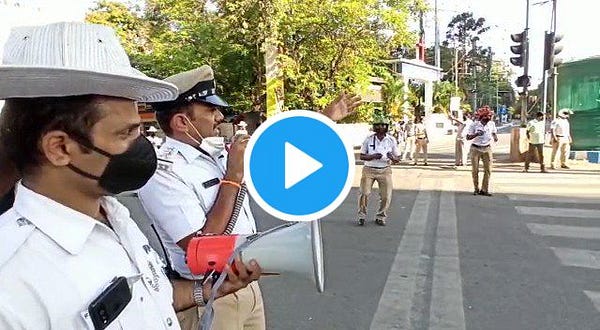The Political Fix: Will Covid-19 crisis slow down Modi’s centralising tendencies?
A weekly newsletter on Indian policy and politics from Scroll.in.
Welcome to the Political Fix by Rohan Venkataramakrishnan, a weekly newsletter on Indian politics and policy. To get it in your inbox every Monday, sign up here.
If you want journalism with spine not spin, consider supporting us either by subscribing to Scroll+ or contributing to the Scroll.in Reporting Fund.

The Big Story: Centrifuge
At the start of 2020, we asked on the Political Fix: Will the states vs Centre battle dominate India over the next decade?
After all, it was assumed when Narendra Modi first took charge as prime minister in 2014 that he might offer a more federal outlook. As chief minister of Gujarat for over a decade, Modi had been vocal about the concerns of the states. On coming to power, one of his government’s key slogans was “cooperative federalism”.
Yet six years later, it is clear that Modi’s tenure has seen even more centralisation than before. Rather than use the Centre to empower the states, Modi, it seems, has sought to run the country as if it were a state.
With India entering the second half of its three-week lockdown effort to halt the spread of the new coronavirus (3,374 cases and 77 deaths in India as of 5 pm on Sunday), this question has once again come into sharp focus.
First, the Centre decided to announce lockdowns in 75 districts, even though only states had the power to do so. Then, invoking emergency powers under the Disaster Management Act, Modi decided to lock all of India down for three weeks, giving residents – and state governments – just four hours’ notice.
The result was a chaotic mess.
Locking down 1.3 billion people was never going to be easy. Undoubtedly, there are aspects of this crisis that require national rather than local action. In Italy, for example, when a limited lockdown was announced in the northern part of the country, there was a huge rush of people towards the south.
But here is the problem: Modi’s sudden announcement of a three-week national lockdown was aimed at preventing large-scale migration. But because his address on March 24 did not reassure citizens who depend on their daily wages to buy their meals and since states had not been given time to work out the specifics of how to feed these vulnerable sections , an exodus – whollypredictable – towards home villages occurred anyway.
As a result, the Centre’s decision to act without consulting the states has come into question.
Similar concerns have been raised about how the Centre is dictating and regulating virus testing policies, its failure to provide crucial data to the states and the public, the manner in which it is distributing testing kits, its management of funds and the manner in which it set up a separate trust, called PM-CARES, to receive donations.

Prime Minister Narendra Modi addresses a teleconference of chief ministers on Thursday. Credit: PIB
Leaders in states have started to become more vocal about this botched-up micromanagement.
“Who is to implement the lockdown? Can the Union government on its own do so?” asked Chhattisgarh Chief Minister Bhupesh Baghel in an interview to the Hindu. “The answer is no. Ultimately, it’s the state government’s job to implement it. Did the prime minister talk to any of the State governments before unilaterally announcing it? No.”
Questions are also being asked about budgets and spending.
“The Centre doesn’t think of the states. We have to manage the crisis,” Kerala Finance Minister Thomas Isaac told the Business Standard. “At least, it should pay what is due to us... The tragedy is that we are at the end of March and Centre has unlawfully kept Rs 40,000 crore due to states.”
My colleague Shoaib Daniyal has three different reports from this week taking a closer look at this issue, and the disagreements between the states that have cropped up as a result.
Diktats from Delhi are harming India’s lockdown – and friction between states doesn’t help
Now, border conflicts within India – as states create barricades to keep out the coronavirus
As India looks ahead to the end of the lockdown, this is going to become even more important.
For the moment, the Centre seems certain that the lockdown will be lifted on April 14, after the three weeks are up – even though the mathematical study that has guided some of the thinking recommends more restrictions.

Rajesh Singh and Rononjoy Adhikari from 'Age-structured impact of social distancing on the COVID-19 epidemic in India'.
Speaking to the chief ministers of states on Thursday, Modi called for a staggered exit from the lockdown, with restrictions continuing on hotspots and containment zones identified by the states. The approach certainly appears to be more consultative than the announcement of the lockdown – but it is one thing for the prime minister to have a video conference with chief ministers, another thing to actually delegate power.
“India needs to move away from command-and-control to coordination and genuine Centre-state collaboration. States are at the frontlines,” wrote the Centre for Policy Research’s Yamini Aiyar and Mekhala Krishnamurthy this week, calling for the Centre to restructure its fiscal response into block grants to the states and for a revival of the inter-state council that would allow for direct cooperation between chief ministers.
The next few months are going to be extremely challenging for India, as it deals with all the health, economic and humanitarian crises.
Will the Centre under Modi be able to suppress its centralising impulses and act as an enabler for the states? Will it sort out the mess of the early weeks while continuing to micromanage things? Or will it end up coming in the way of the states efforts?
The answer will decide how the Coronavirus Crisis plays out in India, and will undoubtedly be a theme we return to on this newsletter.
Modi’s symbolism
Prime Minister Narendra Modi has made three (and a half) addresses to the nation on the coronavirus crisis. Over all three, he has focused on telling Indians what they need to do rather than what the government is doing for them. The half address, on the Mann ki Baat radio show, featured an apology – but, as I wrote, for “taking hard decisions” rather than admitting to bad planning and coordination.
On Sunday, Indians took to their balconies and doors to light candles, diyas or flash their mobile phone torches at 9 pm for 9 minutes because Modi asked them to. He said it was to remind Indians that, even in lockdown, they are not alone.


As with the pots-and-pans event two weeks ago, there was immediately plenty of humour as well as pseudoscience, including the former president of the Indian Medical Association saying the “collective consciousness” could rely on quantum principles to ensure that the virus doesn’t attach to our ACE2 receptors. Seriously.
Despite this, and regardless of all the policymaking mess-ups, as Shekhar Gupta writes this week, Modi remains extremely popular and many Indians remain willing to accept him in this paternalistic role, standing guard over the nation in a crisis. Symbolism like this has always been powerful in Indian politics and it demonstrates how Modi still has tremendous power to guide the actions of people in the country.
Tablighi Jamaat
The narrative of the virus took a turn in India over the last week, after it emerged that a significant number of Indian cases can now be traced back to an event in Delhi well before the lockdown was announced – but just as the capital was putting in restrictions on large gatherings.
The event was organised by the Tablighi Jamaat, a global Islamic missionary group that drew hundreds of people, including some fom nations affrected by the virus.
The sheer numbers emerging out of this one event raise questions about why the Centre was not more active in tracking those entering from virus-affected nations, and about why the leaders of the Tablighi Jamaat did not themselves decide to call off the gathering.
Of course, the story gave much of India’s mainstream media the opportunity to add Islamophobia to their coverage of Covid-19, with some even calling Muslims “corona bombs’, and alleging that they were intentionally spreading the disease.
Some media houses even reported that Tablighi Jamaat members in quarantine were “misbehaving” with hospital staff. It took the Uttar Pradesh more than 48 hours to issue a clarification denying this. That has not stopped the WhatsApp forwards and the outrage.

What will change?
“Covid-19 is the fourth major geopolitical shock in as many decades,” writes Thomas Wright of the Brookings Institution. “In each of the previous three, analysts and leaders grossly underestimated the long-term impact on their society and on world politics.”
The piece argues that the international order that we have grown used to will be stretched to the breaking point by the virus.
But what will it mean for India? We discussed above the potential impact it may have on federalism. And indeed, other trends over the last few years – the growth of Hindu nationalism and majoritarianism, a steady economic slowdown, the shift from a development to a compensatory state – may end up being exacerbated by the crisis.
I wrote this week about how it may end up permanently expanding India’s surveillance state. Are there other fundamental changes that you can foresee emerging from this crisis and its aftermath? Write to rohan@scroll.in
Poll Toon

Recommendation Corner
Kaushik Krishnan, Chief Economist at the Centre for Monitoring Indian Economy, sends in this week’s recommendations:
“These days, I think a lot about democracies slowly sliding into authoritarianism, how it would be to live in such regimes and how they would eventually collapse. Lenin’s Tomb: The Last Days of the Soviet Empire Book, by David Remnick, beautifully captures the collapse of the Soviet Union through stories and rich portraits of individuals living through that time.
I have attempted to read The Odyssey many times, but have only succeeded once. This is thanks to Emily Wilson’s brilliant translation, which is rigorous, crisp and lyrical. It is an absolute delight to read and is full of philosophical and political meditations that are relevant today.
A technical book that I keep coming back to is Monopsony in Motion, by Alan Manning. I strongly feel that the next 25 years of economic thinking in India will focus strongly on jobs and employment. Traditional models of perfectly competitive markets produce theoretical results that are often at odds with the lived experiences of people in, or trying to get into, the labour force.
Manning’s book assumes instead that there are important frictions in the labour market and that employers set wages. The book then rigorously unwinds the implications of such a market on wages, employability, discrimination and the role of the state. Chapter 1 is an excellent non-technical introduction and useful when thinking about the labour market.
These days, podcasts make up a lot of my media diet. I listen to the excellent ones that have been mentioned in the Recommendation Corner before and recommend EconTalk and Rumble with Michael Moore. These two podcasts sit very far apart on the ideological spectrum but are both illuminating on economics and politics. For people looking for something a little lighter, I recommend Reply All, an amazing podcast about technology, the internet and society.”
Have recommendations for an article, book, podcast or academic paper that deals with Indian politics or policy? Send it to rohan@scroll.in. Previous recommendations from the Political Fix are collected here.
Ground Report
Arunabh Saikia brings to life the dangers India faces over the next few weeks as the migrant labour exodus or travel before the lockdown might have brought the virus to India’s rural areas, where healthcare is even harder to access.
This report looks at three cases that reflect the steep challenge ahead, including authorities unwilling to admit lapses:
“The case of the 25-year-old man should have been notified to the disease surveillance authorities and tested for Covid-19 in Basti itself. But that did not happen.
Uttar Pradesh health officials said he exhibited “no critical symptoms” during his time in the Basti district hospital “He just had fever and cough, that’s it,” said Vikasendu Agarwal, who is joint director at the state’s Integrated Disease Surveillance Programme.
However, Basti’s chief medical officer, JP Tripathi, contradicted Agarwal. The patient, he said, had come in a “serious, emergency” state.
On March 29 afternoon, the patient was shifted to Gorakhpur hospital by his family “without informing anyone”, Agarwal claimed. But Ram Prakash, the doctor at Basti district hospital, said he was ferried in an ambulance arranged by the hospital itself.”
We have much much more coronavirus coverage, from its impact on agriculture and harvest season to the plight of migrants who did not walk home and are now struggling to find food to this much talked-about piece, arguing that the virus may end up having a limited impact in India.
Find all of our reports and analysis here. And all of our daily updates here.
And as you read, a reminder – journalism, which is especially needed in times of crisis, is not cheap.
To help ensure our reporters can dig deeper and go further, support Scroll.in by contributing to the reporting fund or, if you are abroad, subscribing to Scroll+.
Linking out
Why is India talking so much about Stage 3 of the virus? What happens after you flatten the curve? Rukmini S has a nightly five-minute podcast throwing light on a different aspect of the coronavirus on each episode.
Will coronavirus force India’s poor to “see the systemic inequalities as a macro level problem and seek recourse from the state?” Roshan Kishore ponders the potential changes to India’s political economy that Covid-19 may cause.
India’s healthcare system is extremely with huge variations in capacity. Shruti Rajagopalan summarises the findings of a timely new working paper co-authored with Abishek Choutagunta that looks at this sector.
At the stroke of midnight on March 24 – the day the lockdown began – India suspended “politics”. Suhas Palshikar argues in the Indian Express that the effects of such a suspension may not be limited to the mismanagement of this crisis and may in fact go much further.
How much money has China sunk into India’s private sector? Ananth Krishnan in this Brookings report estimates that the total amount may be three times the officially announced figure, with many implications for diplomacy, trade strategy and security.
Can’t make this up
If you haven’t seen this little skit Bengaluru traffic police staged to convey the dangers of the Coronavirus, well, go watch it now.
Send in more coronavirus warning videos as well as any other suggestions or feedback to rohan@scroll.in. And if you like this newsletter, please do share it!





